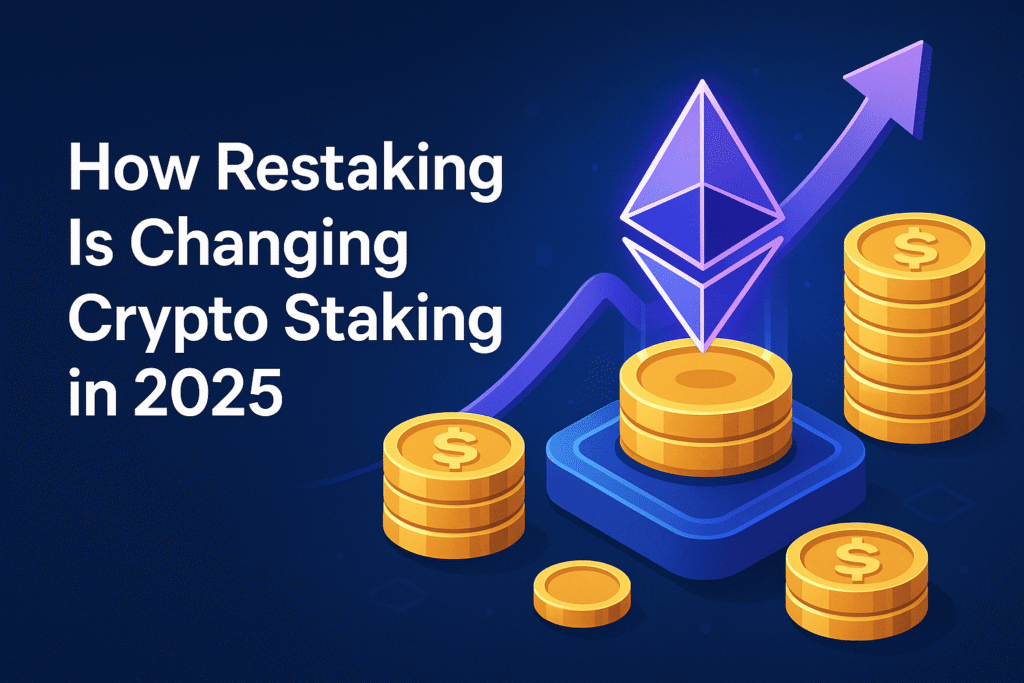How Restaking Is Changing Crypto Staking in 2025
By Abhishek Chandravanshi

Introduction
In 2025, restaking is reshaping the landscape of crypto staking. This powerful new mechanism allows users to earn more from their staked assets while simultaneously boosting the security of decentralized networks. As blockchain ecosystems grow increasingly modular, restaking has emerged as a key innovation—unlocking new rewards, enabling faster protocol bootstrapping, and redefining how we think about network security.
But what exactly is restaking, and why is it such a transformative force in crypto today?
Let’s explore how restaking is changing the staking game in 2025—and how you can use it to your advantage.
Featured Snippet Outline
- What is restaking in crypto?
- How does restaking work in 2025?
- Top restaking protocols and platforms
- Benefits of restaking over traditional staking
- Risks and considerations of restaking
- How restaking is changing DeFi and security models
- Should U.S. crypto users consider restaking in 2025?
- Best platforms for ETH restaking and beyond
- FAQs on crypto restaking in 2025
What is Restaking in Crypto?
Restaking is the process of using already staked assets—like ETH—to secure additional decentralized services or protocols beyond their native blockchain. By opting into a restaking system, users essentially lend the security of their staked assets (and their economic weight) to third-party modules or networks, usually in exchange for additional rewards.
In contrast to traditional staking—where your assets help validate transactions and earn yield on one chain—restaking lets your capital go further. You stake once, but your staked tokens get reused to secure other systems.
Restaking is primarily made possible through platforms like EigenLayer, which launched Ethereum’s restaking revolution by enabling users to opt-in and delegate their security to other protocols.
How Does Restaking Work in 2025?
Here’s a simplified look at how restaking works today:
- You stake ETH through Ethereum’s mainnet or via a liquid staking platform (like Lido or Rocket Pool).
- You opt into a restaking protocol like EigenLayer and allow your staked ETH (or stETH, rETH) to be reused.
- Your staked tokens are now delegated to additional services like decentralized data networks, oracles, or rollups.
- You earn rewards from both Ethereum staking and the services you’re restaking for.
Restaking enables modular blockchain networks to outsource security instead of building their own validator sets—drastically reducing the barrier to launching scalable DeFi or Web3 protocols.
💡 Tip: If you’re using a liquid staking token like stETH, you can restake without locking up your funds completely—maintaining liquidity while stacking rewards.
Top Restaking Protocols and Platforms in 2025
Several protocols dominate the restaking space in 2025. Each offers different features, risks, and reward structures:
1. EigenLayer
- The pioneer and market leader.
- Supports ETH, stETH, rETH, frxETH.
- Hosts dozens of Actively Validated Services (AVSs)—modular services that require economic security.
2. Karak Network
- A data availability layer restaked via EigenLayer.
- Popular among Layer-2s for cheap and scalable DA.
- Now integrated into Optimism’s Superchain and Arbitrum Orbit.
3. BounceBit
- Combines CeFi and DeFi staking.
- Offers restaking with BTC and ETH via custodians.
- Focused on institutional adoption.
4. Ether.fi
- Offers non-custodial liquid restaking.
- Users receive
eETH, a liquid restaked token usable across DeFi. - Prioritizes decentralization and user control.
5. Renzo Protocol
- Provides
ezETH, a highly composable liquid restaked token. - Optimized for DeFi integrations on Curve, Aave, and Balancer
Benefits of Restaking in 2025
Restaking isn’t just a fad—it’s a fundamental shift in ho crypto ecosystems function. Here are the key advantages:
✅ Increased Yield
You earn ETH staking rewards and additional rewards from restaked services. It’s a yield multiplier.
✅ More Utility from the Same Capital
Instead of needing new capital to secure new networks, restaking lets the same ETH support multiple protocols.
✅ Accelerates Ecosystem Growth
New rollups or protocols can launch without needing their own validators, accelerating innovation.
✅ Modular Security
Restaking creates a shared security layer across Ethereum-powered services, leading to more robust decentralization.
Risks and Considerations of Restaking
While promising, restaking does come with added complexity and risks:
⚠️ Slashing Risk
If an Actively Validated Service (AVS) misbehaves or becomes malicious, your restaked ETH could be partially slashed—even if Ethereum itself is fine.
⚠️ Smart Contract Vulnerabilities
Restaking protocols add additional layers of logic and contracts, which can be exploited if poorly audited.
⚠️ Liquidity Risks
While LRTs like eETH or ezETH are liquid, they can depeg or become illiquid during market stress.
⚠️ Centralization Pressure
If a few restaking protocols dominate, this could lead to validator concentration, undermining Ethereum’s decentralization.
How Restaking Is Transforming DeFi and Blockchain Security
In 2025, restaking is the backbone of modular blockchain infrastructure. It’s powering:
- Rollups & Layer-2 Chains: By using restaked ETH, new L2s can inherit Ethereum’s economic security without building their own validator networks.
- Oracles & AI Services: Decentralized oracle networks now rely on restakers to secure accurate data feeds.
- DA Layers: Projects like Celestia and Karak are using restaked capital to ensure availability of off-chain data.
Want to stake more safely? Read Best Stablecoins to Stake Safely in the U.S.
Restaking vs Traditional Staking
| Feature | Traditional Staking | Restaking |
|---|---|---|
| Capital Efficiency | Stake once | Stake once, secure many |
| Yield | ETH rewards only | ETH + AVS + LRT rewards |
| Risk | Limited to one chain | Slashing across protocols |
| Utility | Secure Ethereum only | Secure Ethereum + services |
| Liquidity | Via LSTs | Via LRTs (higher risk) |
Should U.S. Crypto Users Consider Restaking in 2025?
Yes, but with caution.
U.S. users can access non-custodial restaking protocols like Ether.fi and Renzo through wallets like MetaMask. However, centralized platforms like Coinbase and Kraken don’t yet support restaking.
If you’re comfortable with DeFi and self-custody, restaking offers higher APY potential, support for network decentralization, and early adopter incentives.
Always DYOR, check if the LRT is stable, and consider diversification.
Best ETH Restaking Platforms for 2025
| Platform | LRT Token | Custody | Best For |
|---|---|---|---|
| EigenLayer | N/A | Delegated | Advanced users |
| Ether.fi | eETH | Non-custodial | U.S. users & decentralization |
| Renzo | ezETH | Non-custodial | DeFi integrations |
| Puffer | pufETH | Decentralized | Future rewards |
| BounceBit | BBTC, BBETH | Custodial | Institutions |
Curious about how staking compares across platforms? Read Kraken vs Coinbase: Best Staking APY for U.S. Users
FAQs on Crypto Restaking in 2025
❓ What is restaking in crypto?
Restaking is reusing your staked assets to secure additional services or protocols—earning more rewards and providing security to modular blockchain ecosystems.
❓ Is restaking available on Coinbase?
Not yet. You need to withdraw your ETH to a self-custodial wallet and connect to protocols like EigenLayer or Ether.fi.
❓ What’s the difference between LSTs and LRTs?
- LSTs (Liquid Staking Tokens): Represent staked ETH (e.g., stETH).
- LRTs (Liquid Restaking Tokens): Represent restaked ETH across multiple protocols (e.g., eETH, ezETH).
❓ Can I lose my ETH through restaking?
Yes—if a service you restake to is slashed, your ETH can be penalized. Choose trusted platforms and diversify risk.
❓ What are AVSs?
AVSs, or Actively Validated Services, are external protocols secured by restakers via platforms like EigenLayer.
Conclusion
Restaking is one of the most exciting innovations in crypto staking in 2025. It allows stakers to amplify rewards, support the security of emerging blockchain services, and participate in a more composable, modular Web3.
With rising adoption, early user rewards, and deep integrations across Ethereum’s DeFi ecosystem, restaking could very well become the new normal.
Whether you’re a seasoned validator or just starting with ETH staking, it’s time to explore how restaking can unlock new layers of yield and utility.
Explore More on Crypto Staking
- 🔗 Coinbase vs Kraken for ETH Staking: Full Breakdown
- 🔗 Best Crypto APY Rates 2025 on Kraken
- 🔗 Best Ways to Earn Passive Income on Binance
How does restaking improve the security and yield potential for crypto stakers in 2025?Lets Discuss in Comment!
